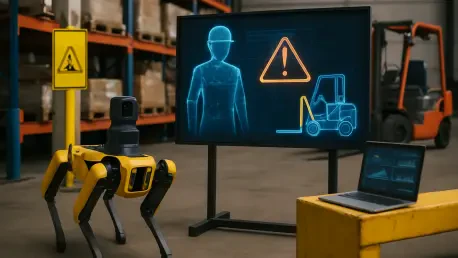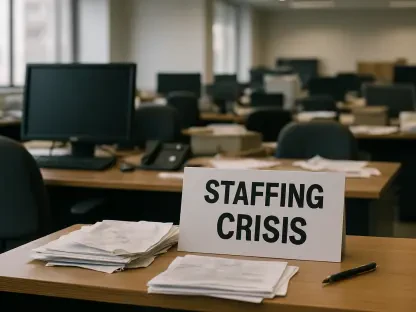In an era where workplace safety remains a critical concern across industries, the emergence of Artificial Intelligence (AI) offers a groundbreaking opportunity to redefine how risks are managed and incidents are prevented. Imagine a scenario where a manufacturing plant could foresee a potential equipment failure days before it happens, or a construction site could identify behavioral patterns leading to accidents before they occur. This isn’t a distant dream but a tangible reality being shaped by AI-driven predictive models. These advanced systems leverage vast amounts of data to uncover hidden trends, enabling organizations to shift from merely reacting to incidents to proactively averting them. The impact of such technology is profound, promising not only to save lives but also to reduce financial losses and enhance operational efficiency. This article delves into the transformative potential of AI in workplace safety, exploring how predictive models can address long-standing challenges, build on proven practices, and chart a path toward a safer future for workers everywhere. By moving beyond outdated methods and embracing data-driven insights, industries stand at the cusp of a safety revolution that prioritizes prevention over cure.
Rethinking Conventional Safety Approaches
Traditional safety models, often rooted in subjective theories rather than hard evidence, frequently fall short in addressing the complexities of modern work environments. Many frameworks, such as the Bradley Curve, rely heavily on anecdotal insights instead of rigorous data analysis, leaving significant gaps in their ability to predict or prevent incidents. As workplaces evolve with new technologies and dynamic risks, these older approaches struggle to keep pace, often resulting in missed opportunities to protect employees. The reliance on intuition over empirical data means that many safety protocols are reactive, addressing issues only after harm has occurred. This outdated methodology underscores the urgent need for a more scientific and forward-thinking approach to safeguard workers in diverse settings.
Another critical limitation of conventional safety strategies lies in the pervasive influence of human bias, which can distort the interpretation of safety data. Cultural backgrounds, personal experiences, and ingrained assumptions often cloud judgment, making it difficult to discern meaningful patterns in the vast amounts of information collected. AI emerges as a vital solution in this context, offering an unbiased lens through which to analyze data. Unlike human evaluators, AI systems are unaffected by emotional or cultural filters, providing a clearer, more objective assessment of risks. This capability is essential for developing safety systems that are not only more accurate but also more adaptable to the unique challenges of different industries, paving the way for a new era of workplace protection.
Addressing the Systemic Nature of Human Error
Human error stands as a dominant factor in workplace incidents, contributing to 80-90% of accidents across various sectors, yet these mistakes are far from random occurrences. Research highlights that error rates can reach as high as 1 in 10 for complex, non-routine tasks, driven by systemic issues such as poorly designed workspaces, time pressures, or inadequate training. Factors like fatigue and stress further exacerbate these risks, creating predictable patterns that can be studied and addressed. Recognizing that human fallibility is often a symptom of broader organizational or environmental shortcomings is crucial. This perspective shifts the focus from blaming individuals to understanding and improving the conditions under which they work, setting the stage for more effective safety interventions.
AI-powered predictive models offer a sophisticated means to tackle the systemic roots of human error by mapping out influencing variables with precision. These models can analyze data from incident reports, employee feedback, and real-time monitoring to pinpoint specific risks, such as high-pressure environments or skill gaps. By identifying these underlying causes, organizations can implement targeted solutions, like redesigning workflows or enhancing training programs, rather than applying broad, ineffective fixes. This data-driven approach ensures that resources are directed where they are most needed, significantly reducing the likelihood of accidents. Moreover, it fosters a culture of continuous improvement, where safety protocols evolve based on actionable insights, ultimately creating a more resilient workforce.
Leveraging Established Safety Pillars with AI
Decades of safety research have identified certain core principles that consistently contribute to fewer workplace incidents, with strong leadership and employee engagement standing out as paramount. Data from Gallup reveals that highly engaged teams experience up to 70% fewer safety issues, alongside benefits like improved productivity and lower absenteeism. Effective safety management systems, proactive equipment maintenance, and a culture of accountability also play vital roles in reducing risks. These established pillars demonstrate that safety is not an isolated concern but is deeply connected to broader organizational health. Building on these foundations is essential for any modern safety strategy aiming to achieve sustainable improvements across industries.
AI enhances these proven safety pillars by delivering precise, data-driven insights into areas where improvements are most needed. Predictive models can assess metrics like employee engagement surveys or maintenance logs to identify potential weaknesses, such as inconsistent leadership practices or overdue equipment checks. By highlighting these specific gaps, AI enables organizations to allocate resources more effectively, ensuring that interventions are both timely and impactful. This integration of technology with traditional safety strengths creates a powerful synergy, amplifying the effectiveness of existing practices while introducing a level of precision that was previously unattainable. The result is a safety framework that is not only robust but also adaptable to the unique needs of each workplace.
Uncovering Invisible Risks Through AI Analytics
One of the most compelling strengths of AI lies in its unparalleled ability to process massive datasets and detect trends that might escape human observation. From sifting through historical incident reports to integrating real-time data from IoT sensors, AI provides a comprehensive overview of safety risks across an organization. This analytical power transforms raw information into actionable predictions, allowing safety professionals to anticipate issues before they escalate into serious incidents. Whether it’s monitoring worker behavior through computer vision or analyzing environmental conditions, AI offers a depth of insight that traditional methods simply cannot match, marking a significant leap forward in risk management.
Beyond mere data processing, AI’s predictive capabilities are particularly impactful in areas like equipment maintenance, where machine learning algorithms can forecast failures long before they occur. By grounding these predictions in established safety methodologies, such as Human and Organizational Performance (HOP) principles, organizations ensure that AI outputs are not only accurate but also relevant to real-world contexts. HOP emphasizes systemic factors over individual blame, aligning seamlessly with AI’s ability to identify root causes. This combination enables tailored interventions, such as adjusting maintenance schedules or refining procedures, that directly address identified risks. Such precision in safety management empowers organizations to stay ahead of potential dangers, fostering an environment where prevention is the norm.
Developing Data-Driven Safety Predictions
Envisioning a mathematical framework to quantify workplace safety risks represents a bold step toward evidence-based prevention, and AI is uniquely positioned to bring this vision to life. By developing predictive equations that account for measurable factors like training effectiveness, maintenance compliance, and leadership quality, AI can estimate the likelihood of incidents with remarkable accuracy. These models treat human factors as integral to every variable rather than isolated elements, reflecting the interconnected nature of workplace dynamics. This scientific approach marks a significant departure from intuition-based planning, offering a structured method to anticipate and mitigate risks before they materialize into accidents.
The iterative nature of AI-driven predictive models ensures that safety strategies remain relevant as workplaces evolve over time. Continuous testing and refinement with new data allow these models to adapt to emerging risks, whether due to technological advancements or changing workforce dynamics. This adaptability is crucial in maintaining the effectiveness of safety protocols in fast-paced industries. Furthermore, by automating much of the data analysis, AI frees safety professionals to focus on implementing solutions and fostering a positive safety culture. The result is a proactive framework that not only predicts potential hazards but also empowers organizations to act decisively, ensuring a safer environment for all employees through sustained, data-informed efforts.
Charting the Future of Safer Workplaces
Reflecting on the journey of workplace safety, it’s evident that the integration of AI with predictive models marked a turning point in how risks were managed. The shift from outdated, reactive approaches to proactive, data-driven strategies redefined industry standards, addressing systemic issues like human error with unprecedented precision. Established safety pillars, such as leadership and engagement, were strengthened through AI’s analytical insights, creating a balanced approach that honored past lessons while embracing technological innovation. The development of predictive equations, tested and refined over time, provided a scientific backbone to safety planning, ensuring that prevention became the cornerstone of workplace protection.
Looking ahead, the path to even safer workplaces hinges on sustained collaboration between human expertise and AI capabilities. Organizations must commit to maintaining high-quality data streams, spanning several years, to fuel accurate predictions while adhering to ethical guidelines that prioritize privacy and transparency. Human oversight remains indispensable in validating AI insights, ensuring that technology serves as a partner rather than a replacement for professional judgment. By focusing on building a culture of continuous learning and improvement, industries can harness the full potential of predictive models, paving the way for innovations that further minimize risks. This ongoing partnership promises to elevate safety to new heights, safeguarding workers through informed, actionable strategies.









